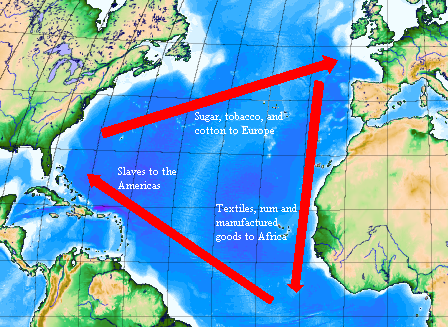 |
en.wikipedia Classical model of the triangular trade |
If you watch the movie Amazing Grace you will see the role that William Wilberforce played in the abolition of the slave trade in Britain. His role was crucial because he was a Member of Parliament, who persisted in introducing legislation over a period of 20 years before the Slave Trade Act of 1807 was enacted. If you watch the movie you will learn of the work of several abolitionists who contributed their labor to the movement.
Not included in the movie is the part that Quakers played in the process. Perhaps it was Quakers who got the ball rolling in 1783 when the London Yearly Meeting presented to Parliament a petition against slave trade signed by over 300 Quakers. Four years later an non-denominational group of nine Quakers and three Anglicans calling themselves Society for Effecting the Abolition of the Slave Trade was formed. The nine Quakers were John Barton, William Dillwyn, George Harrison, Samuel Horne Jr, Joseph Hooper, John Lloyd, Joseph Woods, James Phillips (printer and bookseller at whose shop the group convened), and Richard Phillips.
Three Anglicans were founding members: Thomas Clarkson, author and organizer, Granville Sharp, the lawyer who represented blacks in court cases, and Philip Sansom.
As stated in The Los Angeles Times
"They formed themselves into a committee with what seemed to their fellow Londoners a hopelessly idealistic and impractical aim: ending first the slave trade and then slavery itself in the most powerful empire on Earth."...
"Throughout history, of course, slaves and other oppressed people have periodically staged uprisings. Given the conditions under which they lived, that was only to be expected. But what made the movement that grew out of the George Yard meeting so unprecedented was this: It was the first time that a large number of people in one country became outraged -- and stayed outraged for many years -- over the plight of other people, of another color, in other parts of the world. The movement took off immediately, in a way that earlier scattered abolitionist efforts, in both Britain and North America, never had."
The movie gets its name from the hymn Amazing Grace which was written
by John Newton and first published in 1779. Newton had first gone to sea
at the age of 11. He had first hand knowledge of the brutality with
which slaves were treated. After suffering much himself and causing much
suffering, he ended his seafaring career in 1754 and 10 years later
succeeded in becoming an Anglican priest. When in 1779 the young William
Wilberforce sought his advice on on entering the ministry, Newton
recommended that he "serve God where he was" as a Member of Parliament.
In a biography of John Newton is written:
"It was not until 1788, 34 years after leaving it that he renounced his former slaving profession by publishing a blazing pamphlet called 'Thoughts Upon the Slave Trade.' The tract described the horrific conditions on slave ships and Newton apologized for making a public statement so many years after participating in the trade: 'It will always be a subject of humiliating reflection to me, that I was once an active instrument in a business at which my heart now shudders.' The pamphlet was so popular it was reprinted several times and sent to every member of Parliament. Under the leadership of MP William Wilberforce, the English civil government outlawed slavery in Great Britain in 1807 and Newton lived to see it, dying in December of that year."
Listen on youtube
AMAZING GRACE from 50 Countries
How rich and interesting you make your Blogs, Ellie - what a learning pleasure you make them. Thank You.
ReplyDeleteJo Ann, I always appreciate your comments.
ReplyDeleteIt is a pleasure to find historical tidbits which can be pieced together to make an enlightening narrative. Finding the connections to the subjects that interest me is the best part.